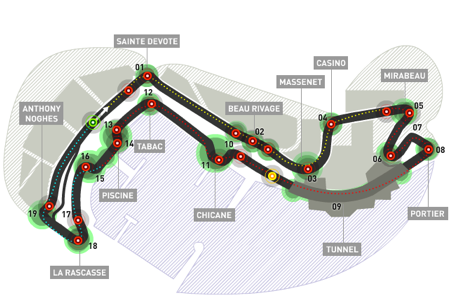Monaco Grand Prix
Probably the most famous, and certainly the most glamorous, Formula 1 race the Monaco Grand Prix is a challenging street circuit unlike any other. For the racing drivers, it carries enormous prestige as it requires pinpoint precision and endurance.
The narrow streets and close barriers do not forgive any mistakes whatsoever. Due to its level of difficulty, the Monaco Grand Prix makes up one of the three races in the ‘Triple Crown of Motorsport’ – the others being the 24hrs of Le Mans in France and the Indianapolis 500 in the USA.
Automobile Club de Monaco
The first Monaco Grand Prix was held in 1929 and organised then, as it is today, by the ‘Automobile Club de Monaco’. In its current form, the race consists of 78 laps, each 3.34km in length, and lasts a maximum of two hours.
The circuit is the narrowest and slowest in modern day Formula 1, with the cars requiring a specialised steering rack and suspension package for just this race to get around tight bends like the Grand Hotel (formally ‘Loews’) hairpin which is taken at just 30mph. The F1 cars run with their maximum possible down-force aerodynamics set-up to help them around the twisty circuit.
Another unique challenge of the Monaco Grand Prix is its tunnel which, despite being illuminated, creates a problem for the drivers going from daylight to comparative darkness and back again with little time for proper adjustment.
Triple Formula One champion Nelson Piquet was fond of saying that racing in Monaco was “like trying to cycle round your living room”, but added that “a win here was worth two anywhere else!”. Ayrton Senna has won the race more times than any other driver, with six victories, winning five races consecutively between 1989 and 1993.
Graham Hill, also known as ‘Mr Monaco’ won the Grand Prix five times, along with Michael Schumacher who holds the current lap record of 1m14.439s set in 2004. McLaren is the most successful F1 manufacturer to race in Monaco.
In 2011, the 69th Grand Prix de Monaco will be held on 29th May and the organisers have agreed a deal with FOM (Formula One Management) to continue racing in the Principality until at least 2020.
Each year the Monaco government resurface at least one third of the streets used in the Grand Prix to minimise how bumpy the roads are for the racing cars. The circuit has changed remarkably little, aside from a modified entry to Rascasse corner and increased capacity for both spectators and the F1 teams themselves.
Spectators can watch the race from a wide range of vantage points, including specially constructed grandstands, roofs of hotels, balconies of offices and apartments and even from luxury super-yachts moored in Monaco’s main port.
Monaco Grand Prix Facts
- Official ticking website: formula1monaco.com
- Race date: 29 May 2011
- Circuit Name: Circuit de Monaco
- Number of Laps: 78
- Circuit Length: 3.340 km
- Race Distance: 260.520 km
- Lap Record: 1:14.439 – M Schumacher (2004)
The noise from today’s F1 cars is so loud it can be heard over 20kms away and the atmosphere of having so many people in the small Principality is incredible!
Monaco Grand Prix Circuit
